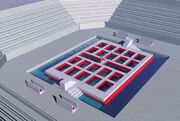Hussade was a Kzinti team sport, described as being very violent.
It was normally played on a gridiron with each team having a "sheirl" at either end. The sheirl was, in most instances, a beautiful woman that served as source of inspiration for a team. The first team to score three points, that is, pulling all three rings on a sheirl's robes, wins. Pulling the first ring meant that the bottom part of the robes came off, the second meant taking off the robes at the waist level and the third ring meant taking off the top.
History[]
Annika Hansen served as sheirl for the team made of Lyran prisoners and Zetra, as well as a Rakelli EMH, played on that team. They both were instrumental in granting the POWs their freedom. (RIS Bouteina: "Hussade Contract")
Some Lyran universities, such as Quendelton State University, were equipped with a hussade pitch and had hussade teams. (Star Trek: False Vacuum: "Asteroid Dusting")
Northwestern University was one of the few Federation universities with a hussade team, on which Estelle Chanteclerc was offered a spot in exchange of which she didn't have to act as a teaching assistant for her physics PhD. NWU's hussade stadium was called the Dome Depot. Federation college-level hussade players were entitled to use any jersey number they wished, even irrational numbers, like worn by Estelle Chanteclerc at NWU. (Star Trek: False Vacuum: "Thesis Dilemma")
- Contemporary NCAA rules would not allow irrational numbers to be worn in competition; yet Estelle wore the number as a Wildcat. Hussade was therefore not a NCAA-sponsored sport, even in the 25th century.
According to Pedicord Apartments, Coridan hosted a high school-level hussade championship. (Star Trek: False Vacuum: "No plot? No problem!")
Playing styles[]
Sheirls are said to be either passive or active; however, being an active sheirl meant that he/she could attack players while not able to leave the platform. Good active sheirls were often converted to play other positions, especially if other regular players got injured, which happened regularly.
Long-jumpers are players at any position who can jump the central moat or, more impressive still, jump from way to way. For this reason, long-jumpers are often used on the offensive. The holographic version of Marina Mur'Eq was a long-jumper. (RIS Bouteina: "Hussade Contract")
Rules[]

The hussade pitch of the Dome Depot
A hussade pitch had six ways, 2.75 m apart, as well as six laterals, 3.75 m apart, while the central moat is 2.40m wide, which can be passed at the center, the edges or jumped. The pitch is situated above a tank of sand (or water, depending on the availability of water on the planet) and a hussade team had 12 players, the captain, the sheirl, 4 guards, 2 forwards, 2 rovers and 2 midfielders. The sheirl could move around a platform at her team's home end of the pitch but cannot leave the platform.
Players buff or body-block opposing players into the tanks, but may not use their hands to push, pull, hold, or tackle (only the sheirl was allowed to do so in the late-24th century and 25th century versions depicted in RIS Bouteina and Star Trek: False Vacuum respectively). The captain of each team carries the 'hange' - a bulb on a three-foot pedestal. When the light glows the captain may not be attacked, nor may he attack. When he moves six feet from the hange, or when he lifts the hange to shift his position, the light goes dead; he may then attack and be attacked. An extremely strong captain may almost ignore his hange; a captain less able stations himself on a key junction, which he is then able to protect by virtue of his impregnability within the area of the live hange.
Background[]
The sport first appeared in the book Trullion: Alastor 2262 by Jack Vance. However, the sheirls needed not to be virgin in the RIS Bouteina depiction of hussade, 3 robe sections needed to be removed rather than one and no ransom was asked by the opposing captain after the ring was pulled.

![{\displaystyle {\sqrt[{e}]{61}}}](https://services.fandom.com/mathoid-facade/v1/media/math/render/svg/f412cb550cac7069fe722e6f8345f2d62e5dc50e)